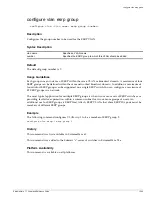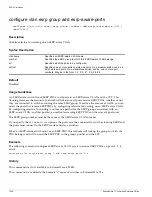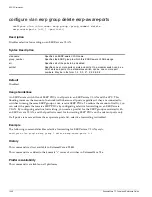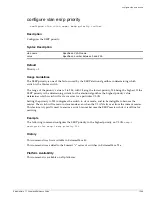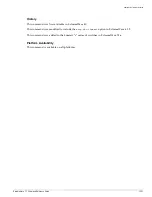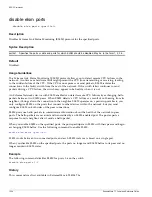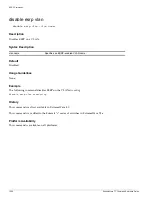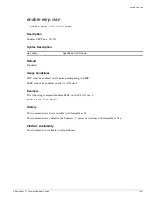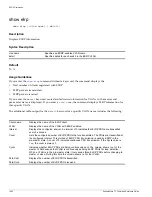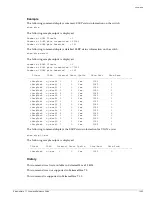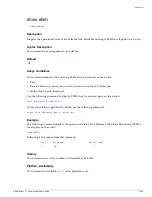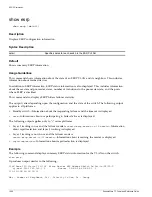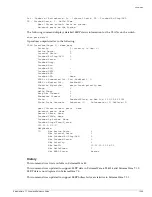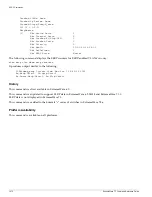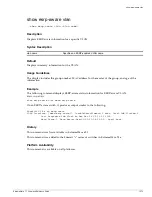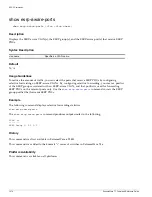
enable elsm ports
ExtremeWare 7.7 Command Reference Guide
1559
enable elsm ports
enable elsm ports <portlist>
Description
Enables Extreme Link Status Monitoring (ELSM) protocol for the specified ports.
Syntax Description
Default
Disabled.
Usage Guidelines
The Extreme Link Status Monitoring (ELSM) protocol allows you to detect remote CPU failures in the
network. A software or hardware fault might prevent the CPU from transmitting or receiving, leading
to the sudden failure of the CPU. If the CPU cannot process or send packets, ELSM isolates the
connections to the faulty switch from the rest of the network. If the switch fabric continues to send
packets during a CPU failure, the switch may appear to be healthy when it is not.
An Extreme Networks device with ELSM enabled can detect remote CPU failures by exchanging hello
packets between two ELSM peers. When ELSM detects a CPU failure as a result of not hearing from its
neighbor, it brings down the connection to the neighbor. ELSM operates on a point-to-point basis; you
only configure ELSM on the ports that connect to other devices within the network, but you must
configure ELSM on both sides of the peer connections.
ELSM ports use hello packets to communicate information about the health of the network to peer
ports. The hello packets are received and transmitted by an ELSM-enabled port. The port expects a
response from its neighbor after it sends a hello packet.
When you enable ELSM on the specified ports, the ports participate in ELSM with their peers and begin
exchanging ELSM hellos.
ELSM works between two connected ports, and each ELSM instance is based on a single port.
When you disable ELSM on the specified ports, the ports no longer send ELSM hellos to its peer and no
longer maintain ELSM states. Use the following command to disable ELSM:
disable elsm ports <portlist>
Example
The following command enables ELSM for ports 1-6 on the switch:
enable elsm ports 1-6
portlist
Specifies the ports or slots and ports for which ELSM should be enabled. May
be in the form 1, 2, 3-5, 2:5, 2:6-2:8.
Summary of Contents for ExtremeWare 7.7
Page 60: ...60 ExtremeWare 7 7 Command Reference Guide Contents ...
Page 72: ...72 ExtremeWare 7 7 Command Reference Guide Command Reference Overview ...
Page 404: ...404 ExtremeWare 7 7 Command Reference Guide VLAN Commands ...
Page 472: ...472 ExtremeWare 7 7 Command Reference Guide QoS Commands ...
Page 492: ...492 ExtremeWare 7 7 Command Reference Guide NAT Commands ...
Page 890: ...890 ExtremeWare 7 7 Command Reference Guide Security Commands ...
Page 1130: ...1130 ExtremeWare 7 7 Command Reference Guide Security Commands ...
Page 1164: ...1164 ExtremeWare 7 7 Command Reference Guide Configuration and Image Commands ...
Page 1436: ...1436 ExtremeWare 7 7 Command Reference Guide Wireless Commands ...
Page 1490: ...1490 ExtremeWare 7 7 Command Reference Guide EAPS Commands ...
Page 1576: ...1576 ExtremeWare 7 7 Command Reference Guide ESRP Commands ...
Page 1774: ...1774 ExtremeWare 7 7 Command Reference Guide IP Unicast Commands ...
Page 1914: ...1914 ExtremeWare 7 7 Command Reference Guide IGP Commands ...
Page 2000: ...2000 ExtremeWare 7 7 Command Reference Guide BGP Commands i Series Switches Only ...
Page 2140: ...2140 ExtremeWare 7 7 Command Reference Guide IPX Commands i Series Platforms Only ...
Page 2156: ...2156 ExtremeWare 7 7 Command Reference Guide ARM Commands BlackDiamond Switch Only ...
Page 2168: ...2168 ExtremeWare 7 7 Command Reference Guide Remote Connect Commands ...
Page 2346: ...2346 ExtremeWare 7 7 Command Reference Guide PoS Commands BlackDiamond Switch Only ...
Page 2446: ...2446 ExtremeWare 7 7 Command Reference Guide LLDP Commands ...
Page 2496: ...2496 ExtremeWare 7 7 Command Reference Guide H VPLS Commands BlackDiamond Switch Only ...
Page 2620: ...2620 ExtremeWare 7 7 Command Reference Guide Index of Commands ...

